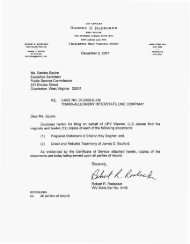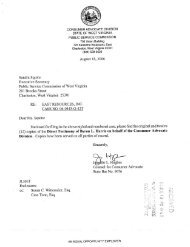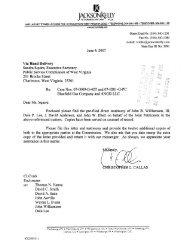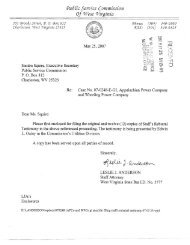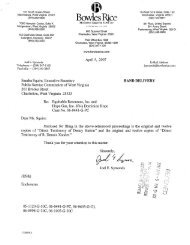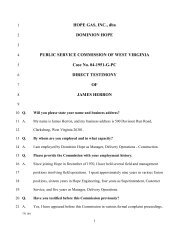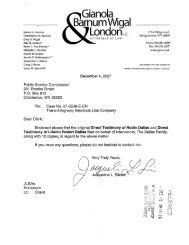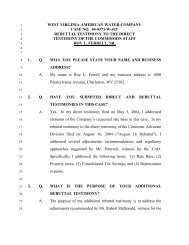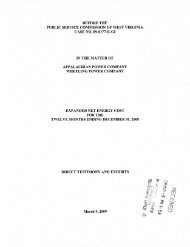Direct Testimony of Thomas M. Hildebrand - Consumer Advocate ...
Direct Testimony of Thomas M. Hildebrand - Consumer Advocate ...
Direct Testimony of Thomas M. Hildebrand - Consumer Advocate ...
You also want an ePaper? Increase the reach of your titles
YUMPU automatically turns print PDFs into web optimized ePapers that Google loves.
17<br />
Section 6: Khat ifthe Line is Bziilt?<br />
1 If the Loudoun line is built:<br />
The PJM system will be inherently less reliable<br />
and more vulnerable to cascading blackouts.<br />
PJM studies show that consumers will pay<br />
more and generators (primarily in western PJM)<br />
will pr<strong>of</strong>it more.<br />
Changes in marginal cost will discourage new<br />
generation in eastern PJM and encourage it in<br />
western PJM.<br />
This will cause a spiral <strong>of</strong> more and more major<br />
west-to-east transmission.<br />
Related jobs, investments, and tax revenues<br />
will migrate from the east to the west.<br />
Environmental damage will be greater.<br />
<strong>Consumer</strong> Costs<br />
If the Loudoun line is built, regional transmission congestion may be reduced.<br />
But a PJM study shows that ratepayers will pay more for power and generators<br />
will make more pr<strong>of</strong>its.I7 To demonstrate this we must analyze the PJM study<br />
and the Byzantine PJM market process. We regret that these are complex. The<br />
complexities have kept people from understanding what will really happen.<br />
When congestion occurs in PJM, the price <strong>of</strong> electricity in the bulk markets goes<br />
up dramatically. To keep generators from reaping windfall pr<strong>of</strong>its, and to protect<br />
ratepayers, part <strong>of</strong> the price increase is captured by PJM and reimbursed to the<br />
ratepayers through "financial transmission rights" or FTRs. The FTR payments<br />
reduce the net costs <strong>of</strong> congestion to ratepayers.<br />
In a 2010 test year, the PJM study shows that ratepayer payments to generators<br />
(summed throughout PJM) will increase by $169 million if the line is built, even<br />
though congestion is reduced. (One would think that reduced congestion would<br />
mean lower payments. The increase is due to defects in market processes.)<br />
In addition, generator production costs (fuel costs) will go down by $140 million.<br />
This saving, though, is not passed through to ratepayers. Rather, the generators<br />
" "Market Efficiency Analysis Preliminary Results," PJM TEAC committee report, Feb. 21, 2007.<br />
Later versions <strong>of</strong> this report analyze a more distant future in three scenarios. Depending on<br />
assumptions about new generation, the benefits <strong>of</strong> the Loudoun line may accrue to generators or<br />
consumers. In the most likely scenario, the benefits accrue to the generators, at the cost <strong>of</strong> the<br />
ratepayers, as in 2010.



